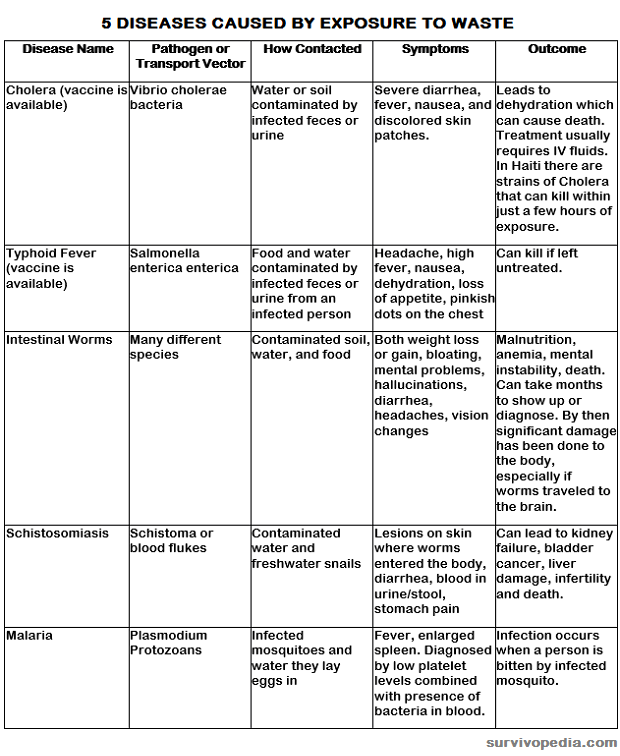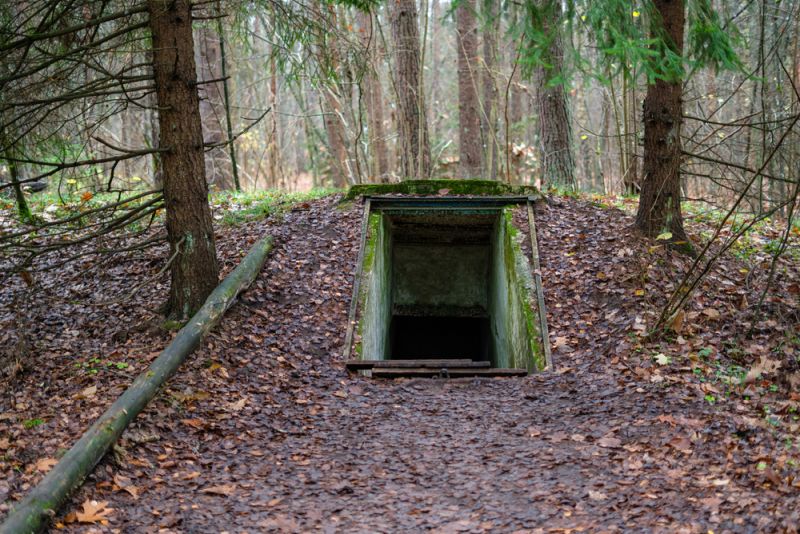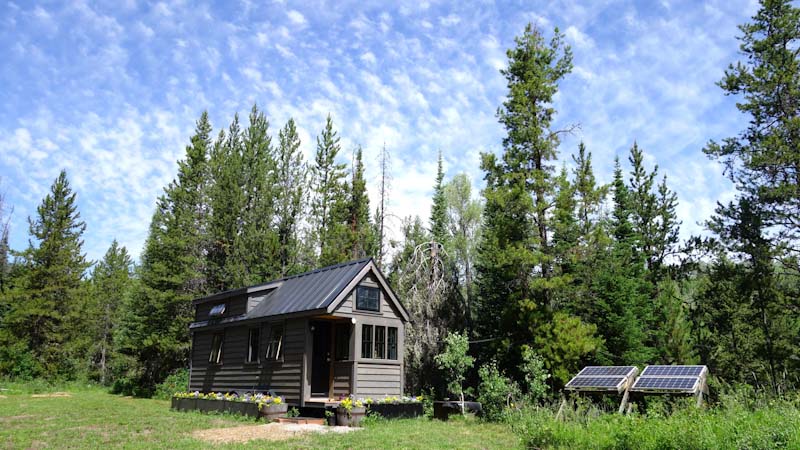In the time after a major crisis. There will be major health problems if waste products are not disposed of correctly. Aside from increased risk of disease and illness, waste can also cause physical injury and death. While some waste can be composted, other types must be managed in different ways in order to reduce harm as much as possible.
Why Is This SO Important??
If you think that adequate waste disposal is not important, here are just a handful of diseases that can be caused by exposure to feces, urine, or other waste.
No matter whether you consume something contaminated by these pathogens or touch a mucus membrane with infected materials, it can lead to enormous health problems and death. In a post crisis scenario, the likelihood of coming into contact with these diseases is much higher than usual.
Methods for Human Waste Disposal
Surprisingly enough, there are many diseases that infect animals that do not cross the species barrier into humans. Therefore, while you can compost cow, pig, and other types of manure, it is not safe to do the same with human feces and urine.
Outside of attempting to build a complete sewage removal system or utilizing leach lines and tanks, here are some fast ways to dispose of human waste that can be used for months and years if needed.
- Cesspools: A cesspool is a pit, storage tank, or a covered dry well that is used to dispose of human waste. Cesspools rely on sewage waster being absorbed by the land around it. Since a cesspool is not a closed system it can be over loaded by rain run off or floods. They can also be damaged by tree roots growing into them. Deep cesspools are dangerous because raw sewage can infect ground water before bio cleaning eliminates pathogens. If you are going to use cesspools, make sure water wells are uphill and as far away as possible from a cesspool. You should allow at least 100 feet between the well and the cesspool.
- Latrine: A latrine is an outdoor toilet. It may only have one hole in the ground or it might be a large trench. Some latrines have floors to stand on, seats to sit on, or footrests to balance on. Latrines may also have walls and a roof to keep out flies and bad weather. As with cesspools, latrines should be built away from rivers, streams, and other water supplies, and downhill (yet above the flood plain) in relation to water sources.
- Outhouse or Privy: Is a small outdoor pit toilet having 1 or 2 seats inside a small shed like structure with a door, a roof, and a simple vent system over a simple pit. The human waste drops below the outhouse into the pit where the waste is stored and broken down. In Vietnam, instead of using a pit, the human waste dropped into a metal pan which was removed daily, and the contents burned. When the burning pan cooled down it was returned to the outhouse or privy. This can be used in areas with high ground water level and other places where pits are not practical.
Controlling Flies and Odor
Once you have an area selected for human waste disposal and treatment, you will still have some issues to deal with.
In particular, the odor from even a single outhouse can be quite noxious. In addition, flies and other pests that land on feces can carry all kinds of diseases.
If flies or other insects land on food or bite you, then you may become infected by everything from bacteria to worms. Here are some ways to control flies and odor in your waste removal area:
- Flies are attracted to light and odors. Therefore, reducing odor can also cut down on fly problems. When the latrines are not in use keep the doors closed and lids down on all of the seats and squat holes.
- To help control odors install vent pipes that are a few feet above the latrine roof.
- Sticky type of fly paper is also useful for controlling flies. Flies land on it and become stuck to the paper and die.
- Lime has been used traditionally to kill odors in latrines and outhouses. It reduces odors by chemically braking done the hydrogen sulfides not just covering them. Lime also helps to reduce the fly and pathogen problems. Just a sprinkle each day with lime will work in most situations. You can make quick lime from limestone. When limestone is heated in a kiln to dry, the carbon dioxide is broken down leaving calcium oxide, which is a form of lime. To keep the lime supply from being contaminated, keep it in an air and water tight container.
- Sawdust: Sprinkle sawdust down the hole after using the toilet. This will reduce the odor and aids in decomposition of solids in the pit.
- Cedar Shavings: Much better odor control than sawdust, and aids in decomposition of pit solids.
- Wood Ash: Wood ash from wood fires or wood stoves can be spread over waste in a latrine or an outhouse.
- Straw or Peat Moss: Straw or peat moss may be used to control latrine or outhouse odors. The straw and peat moss must be shredded before use. This will encourage the formation of a crust on top of the waste, which helps reduce the odor. This crust also aids in the decomposition of waste material.
Things NOT to Do in the Latrine or Outhouse
If you have ever watched TV shows featuring outhouses or latrines, you may mistakenly believe they are safe places. Unfortunately, these areas frequently build up toxic and flammable gasses that can pose serious risks to your health if not managed correctly.
When using an outhouse or latrine, you should never:
- Do not drop lit matches or cigarette butts down into the pit because methane gas from waste breakdown may be in the pit. Methane, in turn can cause a fire or explosion which could be hazardous to your health.
- Do not pour bleach or other chlorine products down into the pit. Chlorine gas will react to the ammonia in urine and produce a gas that can kill if inhaled.
- Do not let small children use the latrine or outhouse by themselves because they might fall in and get hurt.
- If you lose a cellphone or something of value down the latrine or outhouse do not try to recover it. It could cost you your live if the pit is deeper than you thought. Death by suffocation or drowning is a horrible way to go.
What About the Animal Waste?
Animal waste is high in phosphorous and nitrogen, which makes it a good ingredient for fertilizer.
Adding lime to the waste can neutralize the flammability of the nitrogen in the waste and make a safe concentrated fertilizer. Lime also inhibits pathogens by raising the PH levels to a point where pathogens cannot survive.
How to Dispose of Household Garbage

The fire kills all pathogens that might infect humans and also produces ash that can be leached for lye and soap products.
Plant and Vegetable Waste
Plant and vegetable waste can be disposed of by using compost piles. You should not mix plant and vegetable waste with animal manure. To build a compost pile for plant waste:
- Put plant and vegetable waste in a pile and add earthworms if you can find them.
- Turn over the pile 2 or 3 times a week. If you have successive compost piles going, this is a perfect place to keep earthworms for fishing.
- It is natural for the compose pile to get warm to the touch.
- When the plant material is reduced to a fine dark looking soil it is time to mix it into the garden.
Managing Dead Human and Animal Bodies
In the time after a major crisis there will be numerous corpses that must be buried or cremated. The major problem is how to do it without spreading disease. Never handle a corpse without rubber gloves and sufficient garments.
If you use a canvas apron or gown, it must be washed in bleach after each use. It should be noted that bodies contaminated by nuclear radiation should not be handled at all, or only when a geiger counter (if you can get one) shows the body is cool enough to handle.
There are two basic ways to dispose of bodies without setting aside large areas for cemeteries:
- Burn the body and Bury the Ashes. Depending on the cause of death (such as plague) and the condition of the body or bodies, it may be best to burn the bodies and bury the ashes. This would be done if there was a major plague or other major outbreak of a communicable disease. Start by digging a large fire pit and build a large fire. When the fire is big and hot enough place the body or bodies into the fire. Keep the fire burning by adding more wood until all that is left of the human remains is ash and small bones.
- When the fire pit is cold, fill in the fire pit and leave a grave marker for humans (and pets if you so choose).
- Use lime and bury. The technique of placing lime under and over a body has been used for centuries to help keep down infectious diseases. To use this method, start by digging a grave at least 6 feet deep (or over 10 feet if it is to be a mass grave). Put lime down on the inside of the grave and place the body or bodies in the grave. Next, put a few inches of inches of lime on top of them. Finally, fill in the grave and place a grave marker at the head of the grave for humans interred and pets if you wish to do so.
In a time after a major crisis your bug out location can quickly become a dangerous death trap if you do not manage waste related issues. Human, animal, household, and body waste disposal must be done correctly or you and others may get very sick or die because the basic principles of sanitation were not followed.










Adrian | June 30, 2014
|
What about using human manure for making methane gas for cooking/ boiling?
terry | June 30, 2014
|
You are wrong about composting human feces and urine. It is done everyday around the world and is easy and safe. If you want to get more info
http://www.humanurehandbook.com
I an surprised you never came across this in your research
Tracey Pera | October 6, 2016
|
He did mention ‘humanure’… outhouse/ sawdust… this is it.
John | July 28, 2018
|
Mixed with kitty litter disposable?
Bud Pavey | June 30, 2014
|
where is a good place to purchase lime?
Lex | June 30, 2014
|
Most garden supply stores have lime to change soil ph from acidic to alkali
C.s. | July 1, 2014
|
You can find lime at a lawn and garden store like Wal-Mart, Home Depot, Lowes, etc. They have all kinds of fertilizer and the lime can be powered or pelleted.
Pingback:Prepper News Watch for June 30, 2014 | The Preparedness Podcast | June 30, 2014
|
Charles sutton | July 1, 2014
|
When I was in Vietnam in the ’60s the natives all went into the rice fields and just squatted and did their poo right in the open…
Frederick Tyrrell | July 1, 2014
|
Charlers Sutton,
Do you remember those wounderful days of Boot Camp when the medics ran you down the valley of death (those shots in both arms) that made you so sick? That is what protected you from catching all those diseases from people pooing in the rice paddies and in any place where you might drink water. The people themselves did get sick (and they still do in 3rd world countries); but the numbers were/are lower because have a greater natural immunity to these diseases. We also don’t know the real numbers of casualties from disease caused by human waste because they go unreported.
Today, there is a huge movement (no pun intended) to end some of the most important vaccinations that children can get because of suspected poisoning from some of the ingredients. I have seen the consequences of these childhood diseases and also lost friends from ailments caused by dirty water and food – including worms from bathing in contaminated water. In a time of crisis – this will only get worse because vaccines that people commonly get in childhood or before going overseas will not be available. Those diseases are still all around us, however we are protected by vaccinations just as you were in Vietnam.
The other problem with any system is there is an inclination to get sloppy. Even in modern sanitation systems, water gets released at the wrong time in the cleaning cycle, people forget to use appropriate water purification methods, or they just stop caring. Human waste in these circumstances will spread disease faster.
In closing – you can compost any kind of organic matter; however human waste is still very dangerous and should not be done unless you have practiced in a safe setting where you can also get whatever medical assistance is available in good times. That being said, I wrote this article from the perspective of having seen people with brain rot and screaming from organ failure with IVs and antibiotics around the clock from diseases caused by human waste. It does not leave me inclined to try it or recommend it.
Philip Good | August 5, 2017
|
Little wonder many of the countries where that is the practice, they are over run with disease that could be avoided if they were taught better methods for disposing of human waste
Pingback:Waste Disposal When Living Off the Grid | TheSurvivalPlaceBlog | July 2, 2014
|
Pingback:How to Build an Outhouse | Survival skills, survival guns, survival guide | October 10, 2014
|
Pingback:How to Build an Outhouse | The Prepper Dome | October 10, 2014
|
Pingback:Farming Know-How: The Science Of Manure Management | Survival skills, survival guns, survival guide | November 10, 2014
|
Delores Lyon | March 6, 2015
|
Thanks for sharing this! It really is important to take care of waste as soon as possible. Even if you live off the grid, it is no excuse to not take care of yourself and your family. Just seeing this list of diseases should be enough for anyone to start disposing their waste more effectively!
Pingback:The Basic List For Your EMP Survival | Wichita Observer | November 23, 2015
|
Pingback:Survival Projects to Study This Winter: DIY Outhouse | Survivopedia | January 3, 2016
|
Pingback:Survival Projects to Study This Winter: DIY Outhouse | Prepper's Survival Homestead | January 3, 2016
|
Pingback:Quick Guide For A Comfortable Shelter | Prepper's Survival Homestead | June 5, 2016
|
Pingback:Quick Guide For A Comfortable Shelter | Survivopedia | June 5, 2016
|
Pingback:Quick Guide For A Comfortable Shelter | NewZSentinel | June 5, 2016
|
Pingback:Quick Guide For A Comfortable Shelter | | disasterdefense.us | June 6, 2016
|
Pingback:8 Signs Your Stored Foods Could Kill You | Survivopedia | June 22, 2016
|